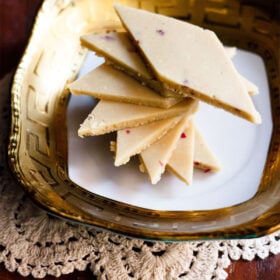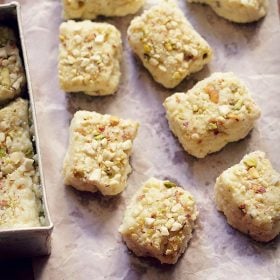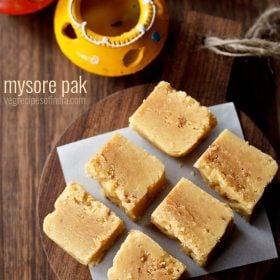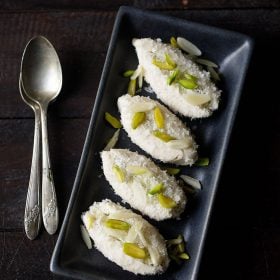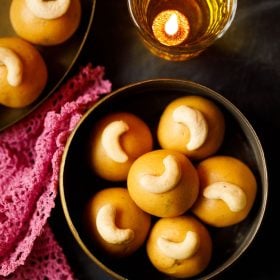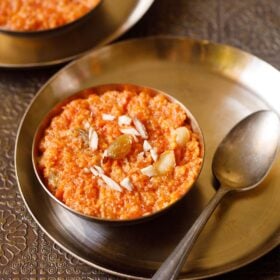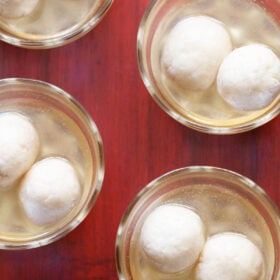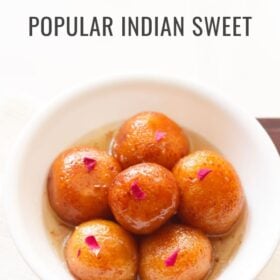Make one of the most popular Indian sweet, Gulab Jamun! My step-by-step photo guide will help you to make these Indian treat perfectly every single time. I share the traditional method of making Gulab Jamun with Khoya (milk solids) which yields soft, rich and juicy jamuns. If you are out of Khoya, check my recipe of Milk Powder Gulab Jamun which is also easy to make.
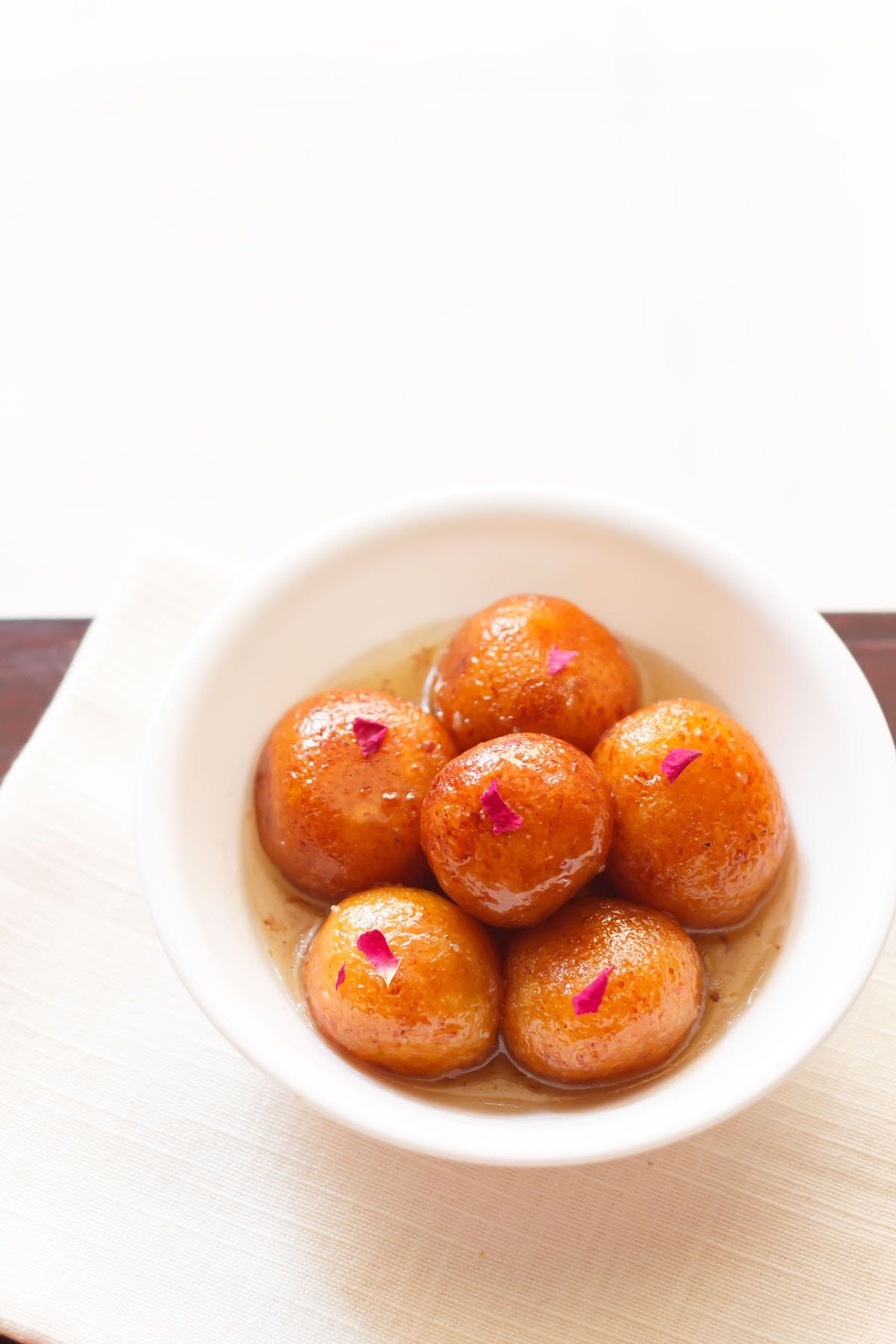
What is Gulab Jamun
Gulab Jamun is a very popular Indian sweet made from deep fried balls of milk based dough that are soaked in sugary syrup. It is a favorite dessert of ours, and we often serve it for weddings, birthdays, festivals, parties or even as a post-prandial treat.
Gulab jamun can literally be translated to “rose berries,” and are so named because the sugar syrup is scented with rose water and the fried dough balls are a similar size to a dark purple berry known as black plum or java plum.
Traditionally, gulab jamun is made with dried milk solids, also known as khoya or mawa in Hindi. This method yields the best tasting and most melt-in-your-mouth texture.
An easy version is also made with milk powder, in case you don’t have access to khoya. In this post I am sharing both versions, so choose your own adventure!
About This Recipe
Authentic Gulab Jamun is always made with khoya or mawa (evaporated milk solids). Khoya is made by continuously simmering the milk on a low heat until most of the moisture evaporates.
There are 3 different types of khoya that you get in an Indian market. To make this gulab jamun recipe, you need to use either “chikna khoya” or “dhaap khoya”. This variety has more moisture than the other two types of khoya, ‘danedar khoya’ and ‘batti khoya’.
Besides khoya, you will also need paneer to make the jamun. The addition of these two ingredients gives the balls a soft, tender texture that is very addictive.
My gulab jamun recipe is an easy one that yields delicious, soft and tasty sweet. It is adapted from the recipe we learned at cooking school, and I have been making it for decades. It has never once failed!
How to Make Gulab Jamun
Follow along with my easy pictorial guide below to make the best gulab jamun you’ve ever eaten!
Make Jamun Dough
1. Take 1 cup khoya or mawa (200 grams) in a bowl. Soft khoya also known as ‘daap ka khoya’ or ‘chikna khoya’ is used. This is a soft khoya, so it mashes and kneads very well.
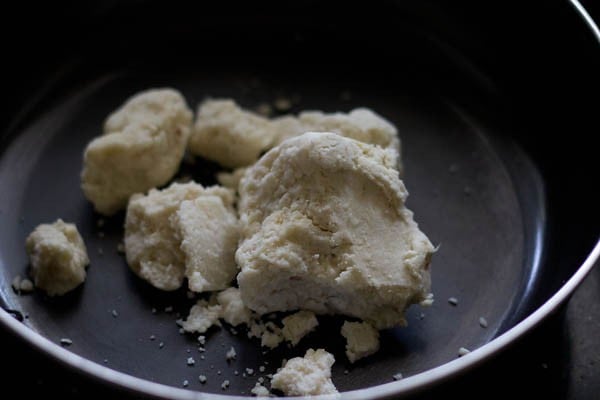
2. Mash khoya very well, ensuring there are no lumps or small bits lurking.
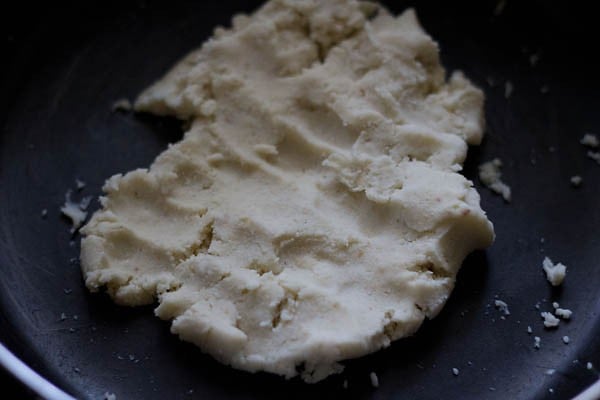
3. Then add ¾ cup (100 grams) grated paneer, 2 tablespoons fine rava (semolina), 2 tablespoons all-purpose flour, ¼ teaspoon baking powder and ½ teaspoon cardamom powder to the mashed khoya.
There should be no lumps in either the mawa or paneer. If there are lumps, then the texture is not even and smooth. The bits and pieces of mawa or paneer give a bite while eating.
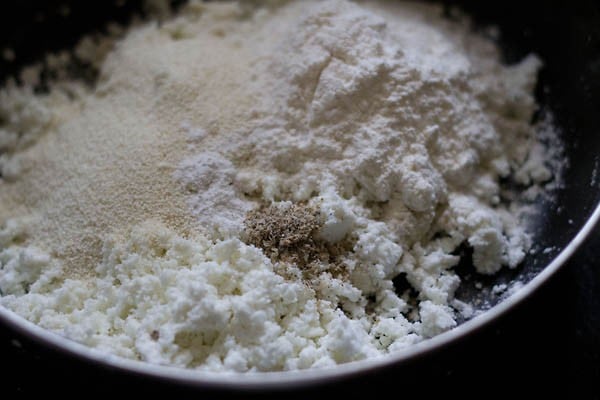
4. Mix well.
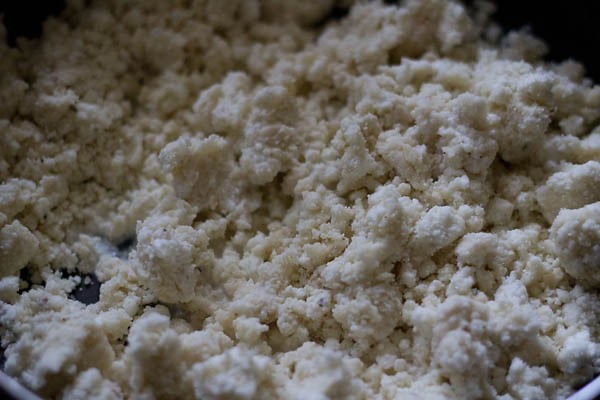
5. Add 1 tablespoon milk and gather together to form a dough with milk. Don’t knead, just gently mix.
If you are unable to form balls or if the mixture appears dry, then add a few teaspoons of milk and mix again. Cover the dough and set aside for 30 minutes.
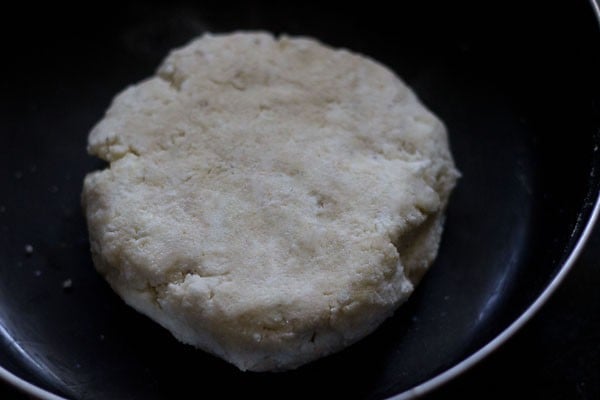
Make Sugar Syrup
6. Mix 1.75 cups (250 grams) sugar in 1 cup water.
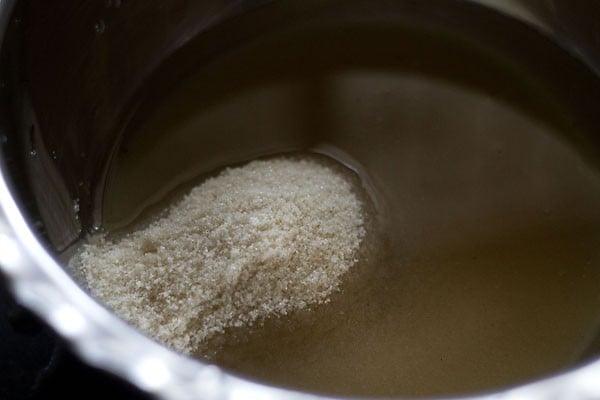
7. On a medium-low flame, heat the sugar solution till it becomes thick and sticky. Just be sure to switch off the heat before the syrup reaches a one thread consistency.
I used raw sugar here, which contributes to the dark color of the syrup.
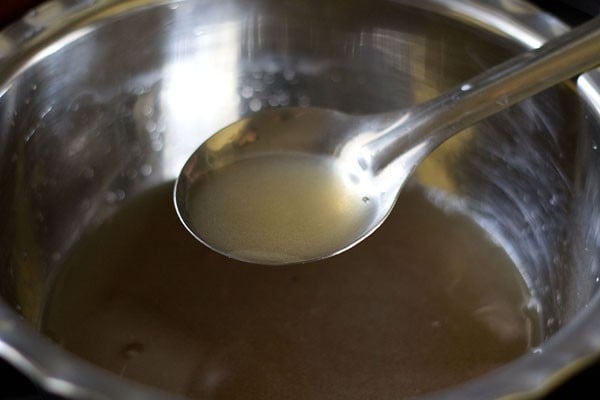
8. Add rose water and stir. Set the sugar solution aside.
If the sugar syrup crystallizes while cooling, then just add 2 to 3 tablespoons water and warm the syrup again. Stir while warming the syrup. The sugar crystals will disappear.
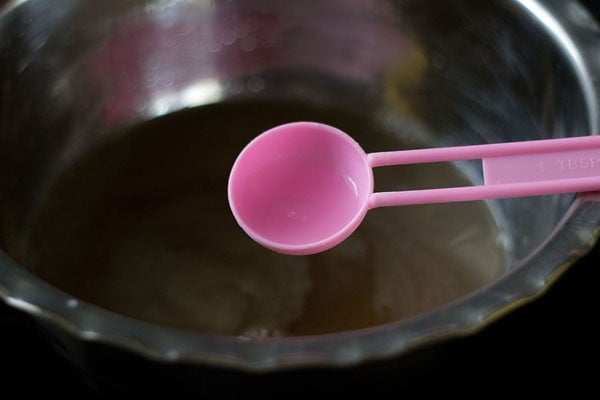
Shape and Fry
9. After 30 minutes, make small balls from the dough without cracks. Cover the dough balls and set aside.
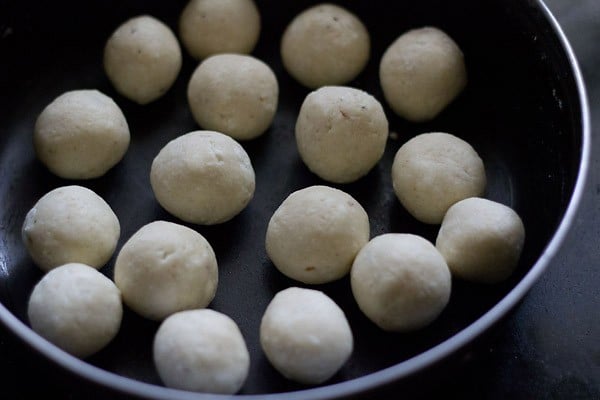
10. Heat oil until it is medium-hot. Lower the heat to a medium-low or low and wait for a minute. Then gently place a single dough ball in the oil.
If the dough ball breaks when frying, then add some more maida (about 1-2 tablespoons) to the dough. Mix gently again. Set aside for fifteen minutes, then shape and fry.
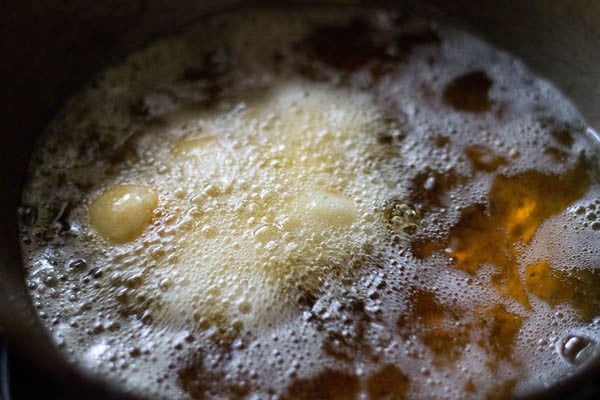
11. Once the jamun start to have tiny golden spots, keep on rotating them in the oil so that the balls are evenly browned. Since I was taking the photos, I browned a few of them more.
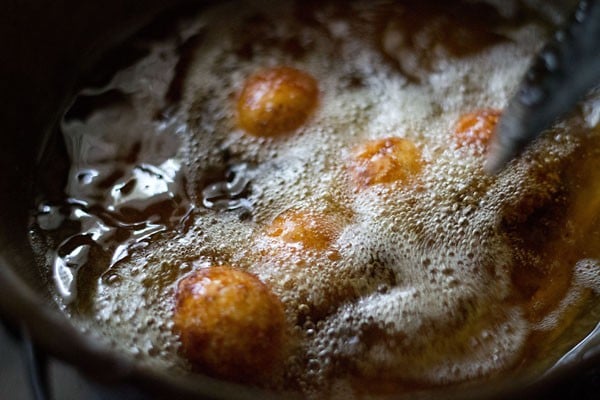
12. Remove the fried dough balls and then place them on paper towels to remove extra oil.
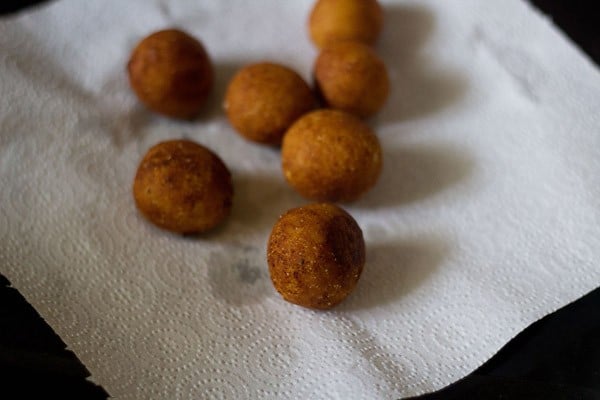
Soak Jamun in Sugar Syrup
13: Place the hot fried dough balls in the sugar syrup. Continue to fry the rest of the dough balls in batches, giving them a quick drain on paper towels before adding them to the sugar syrup while they are still hot.
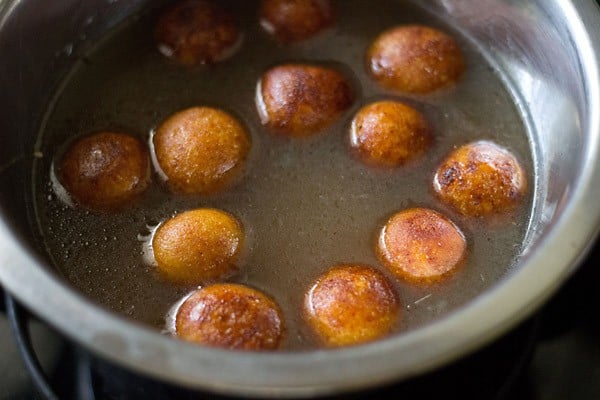
14. When all the gulab jamun are placed in the sugar syrup, then keep the whole pan on a low flame for 1 to 2 minutes. Heating helps the jamun to absorb the syrup and become soft.
The gulab jamun will increase a bit in size during this soaking process. Don’t overcook them, as then they can break.
Use a large enough pan so that the fried jamun balls are not overcrowded and you can easily stir them gently while they are simmering.
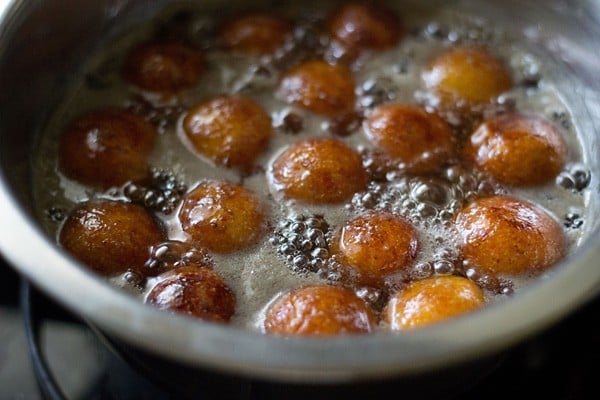
15. Serve gulab jamun warm or at room temperature. You can also chill them and serve them cold. Garnish them with rose petals or almond slivers. Enjoy!
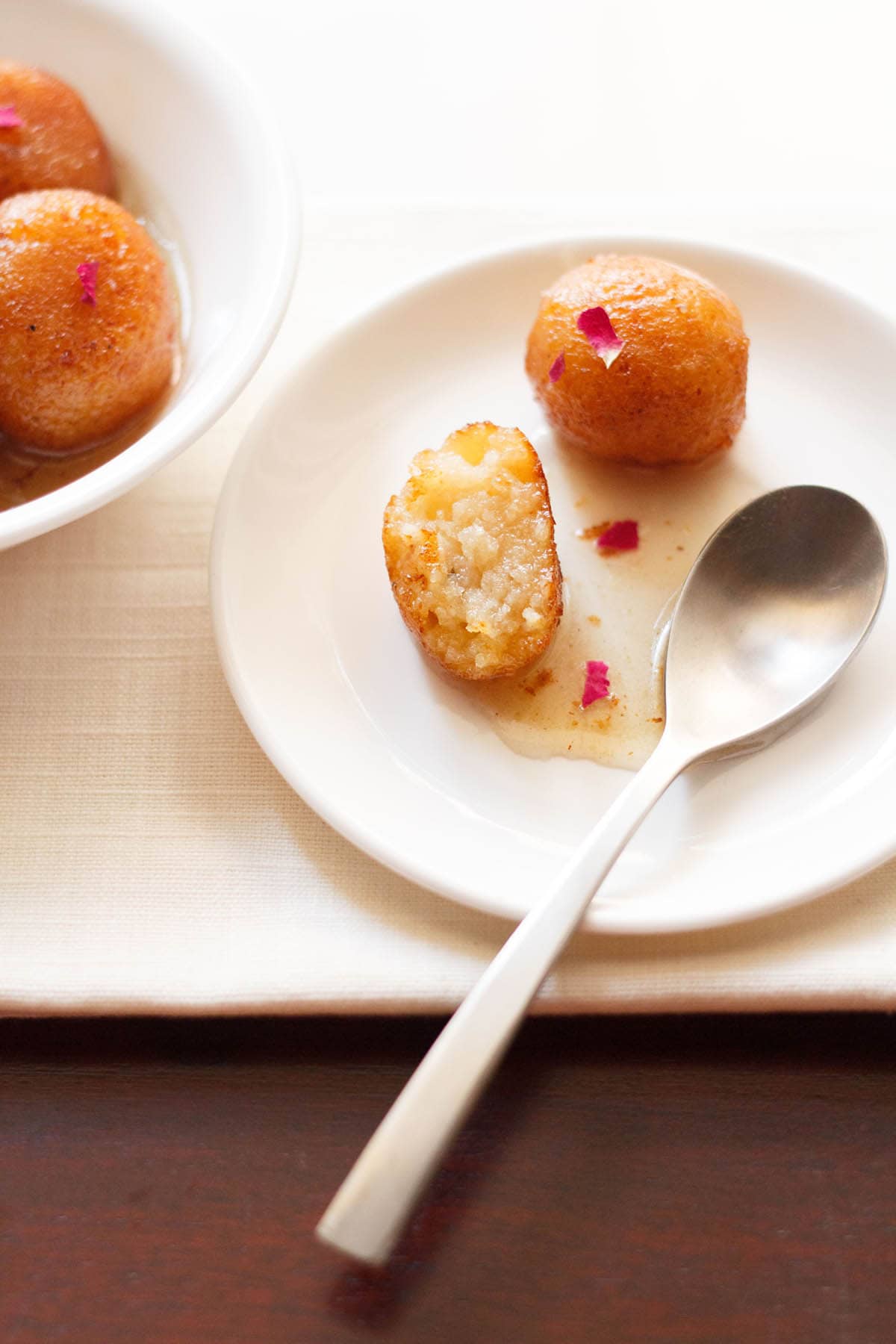
Expert Tips + FAQs
I have compiled below tips and frequently asked questions based upon the queries received from the readers in the comments section.
How to perfectly fry?
Making gulab jamun isn’t difficult, but there are some things you should know about deep frying.
- First, the oil has to be heated till it is medium hot. Then reduce flame to a medium-low or low and wait for a minute. Start by testing just a single gulab jamun to make sure that the oil is hot enough to bubble, but not so hot that the outsides get cooked before the insides get a chance.
- If the oil is on the cooler side, then the jamun will become soggy with oil.
- If the oil is very hot, then the balls get browned quickly with the inside portion being under cooked.
- Once the jamun dough balls start to have tiny light golden spots on them, then keep on rotating them with a slotted spoon in the oil often. This way the jamun will have an even golden color.
- Traditionally gulab jamun are fried in ghee. You can go the traditional way if you want, or just fry them in a neutral oil as I have done.
Why does my gulab jamun break on frying?
There are several possibilities:
- If there is too much moisture in the dough, the jamun will break in the oil.
- Too much baking powder can also result in the jamun breaking and disintegrating in oil.
- When frying the temperature should not be too high or too low.
- If you don’t add enough of the binding ingredients like all-purpose flour or rava (sooji), then this can cause the jamun to break.
- As soon as you add the jamun dough balls in the oil, then let them become slightly crisp and only then turn them.
- When making jamun dough ball, there should be no cracks on it. If you see cracks then add some more milk in the dough mixture. Mix, rest and then form the jamun again.
Why has gulab jamun become hard?
First, check your ingredient proportions. If there is less moisture in the jamun, it may become hard.
The jamun dough has to be mixed and not kneaded. If the dough is kneaded then the gulab jamun will become hard.
When you knead the dough, gluten strands will form which will make the jamun dense and heavy, and prevent them from soaking up the syrup.
Even if they are slightly dense they won’t absorb the syrup and thus remain hard. In fact when frying gulab jamun, it should feel like very light spongy balls. You will feel the lightness in them.
Why is my gulab jamun too soft?
The sugar syrup should have a sticky consistency, not watery. If the sugar syrup is watery, then the jamun absorbs too much sugar syrup, which often results in them breaking in the syrup.
Variations
There are many variations of gulab jamun. The variations vary with the ingredients used or the cooking technique applied. Some of the variations that I have already shared are:
More Awesome Indian Sweets!
Sweets Recipes
Sweets Recipes
Sweets Recipes
Sweets Recipes
Please be sure to rate the recipe in the recipe card or leave a comment below if you have made it. For more vegetarian inspirations, Sign Up for my emails or follow me on Instagram, Youtube, Facebook, Pinterest or Twitter.
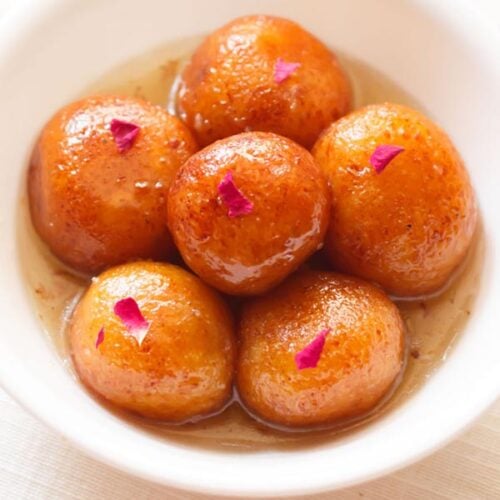
Gulab Jamun Recipe
Ingredients
For the jamun dough
- 1 cup (200 grams) Khoya (mawa)
- ¾ cup (100 grams) grated paneer (Indian cottage cheese)
- 3 tablespoons all-purpose flour
- 2 tablespoons sooji (rava or semolina), finer variety
- 4 green cardamoms – powdered in a mortar-pestle or ½ teaspoon cardamom powder
- 1 tablespoon milk or add as required
- ¼ teaspoon baking powder
- oil for deep frying – as required
For sugar syrup
- 1.75 cups (250 grams) sugar
- 1 cup water
- 1 tablespoon rose water
- 1 tablespoon milk (optional) – *read notes
Instructions
Making dough
- Take khoya (mawa or evaporated milk) in a bowl. Mash it very well. There should be no lumps. You can also grate and then mash the khoya.
- Then add grated paneer, rava (sooji), all purpose flour (maida), baking powder and cardamom powder to the mashed khoya.
- There should be no lumps in both the mawa and paneer. As if they are there, then you will find the texture of the gulab jamun not so good. The bits and pieces of mava or paneer will give a bite in the mouth, when you have the gulab jamun. They won't be smooth.
- Mix well. Add milk and gather together to form a dough with milk. Don’t knead.
- Just gently mix. If you are unable to form balls or if the mixture appears dry, then add a few teaspoons of milk. Cover the dough and keep aside for 30 mins.
- Make small balls from the dough. Cover the balls and keep aside.
Making sugar syrup
- Dissolve sugar in water. Heat the sugar solution till it become sticky. You just need to switch off the fire before the syrup reaches a one thread consistency.
- Add rose water and stir. Keep the sugar solution aside. On cooling if the sugar syrup crystallizes, then just add 2 to 3 tbsp water and warm the syrup again. It will again return to a liquid state.
Frying
- Meanwhile, while the sugar syrup is cooking, heat oil till its medium hot. Lower the flame and wait for a minute. Then gently place the dough balls in the oil.
- Once they start to have tiny golden spots, keep on rotating them in the oil, so that the jamun are evenly browned.
- Remove the fried jamun and then drain them on kitchen paper towels to remove excess oil.
Making gulab jamun
- Then place the hot fried dough balls in the sugar syrup. Continue frying the rest of the dough balls in batches.
- When all the jamuns are placed in the sugar syrup, then keep the whole pan with the sugar syrup and the gulab jamun, on a low heat for 1 to 2 minutes till the jamun become soft.
- Heating helps the gulab jamun to absorb the syrup and become soft. The jamun increase a bit in size. Don’t overcook as then the jamun can break.
- Use a large pan, so that the jamuns are not overcrowded and you can easily stir them gently while they are simmering.
- Serve gulab jamun warm or at room temperature. You can also chill them and serve them cold. Garnish with rose petals or almond slivers.
Notes
Recipe Notes
1. Gulab jamun falls apart while frying: The jamuns will fall apart of break in oil, If there is too much moisture in the dough. More baking powder in the dough can also result in the same. Frying at a very high heat or a low heat will result in the jamuns cracking or falling apart. If the dough has less binding ingredients like all purpose flour or rava (sooji), this would break them in the oil. While frying as soon as you add the jamun dough balls in the oil, then let them become slightly crisp, firm up and then only turn them. 2. Dense gulab jamuns: Less moisture in the jamun dough will make them hard and dense. The jamun dough has to be mixed and not kneaded. If the dough is kneaded then the gulab jamun will become chewy. When you knead the dough, gluten strands will form which will make the jamun dense and heavy. 3. Very soft gulab jamuns: The sugar syrup should have a sticky consistency. They should not have a watery consistency. If the sugar syrup is watery, then the jamun absorbs more sugar syrup resulting in it being super soft and can even break in the sugar syrup. 4. Tip to remove sugar impurities: If the sugar syrup has impurities, then add milk and simmer. A layer of scum will be formed. Remove this layer with a spoon.Frying Notes
- First, the oil has to be heated till it is medium hot. Then reduce flame to a medium-low or low and wait for a minute. Then gently place the jamun dough balls in the oil.
- Once the jamun dough balls start to have tiny light golden spots on them, then keep on rotating them with a slotted spoon in the oil often. This way the jamun will have an even golden color.
- Also do note that if the oil is on the cooler side, then the jamun will absorb more oil and can crack or break too.
- If the oil is very hot, then the balls get browned quickly with the inside portion being under cooked.
- Traditionally gulab jamun are fried in ghee. You can go the traditional way if you want or just fry them in oil as I have done.
Nutrition Info (Approximate Values)
This Gulab Jamun recipe from the archives was first published on August 2014. It has been updated on November 2024.
